- MENU -
所長あいさつ
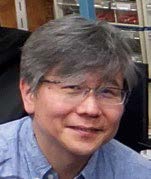
所長:北野 晴久 物理科学科 教授
「先端技術研究開発センター / CAT(Center for Advanced Technology)」は、文部科学省(旧文部省)の1996年度「私立大学ハイテク・リサーチ・センター整備事業」に選定され、1998年度、青山学院大学理工学部に附置されました。これは科学技術の発展における私立大学の重要性の認識から創設された事業で、充実した研究施設のもと、「世界をリードする研究」・「外部に開かれた研究」を基本理念として、選定された研究プロジェクトに対してハードとソフトの面から支援を行うものです。
現在までに実施された大規模プロジェクトには、3期15年にわたる「私立大学ハイテク・リサーチ・センター整備事業」(第1期:1997年度~ 2001年度、第2期:2002年度~2006年度、第3期:2007年度~2011年度)、「21世紀COEプログラム」研究拠点(2002年度~2006年度)、「私立大学戦略的研究基盤形成支援事業」(2プロジェクトが同時採択:2013年度~ 2017年度)、「私立大学研究ブランディング事業」(2016年度~2020年度)があり、この他にも外部資金による1期最長3年のプロジェクト(2002年度から合計13件を選定)を数多く実施してきました。2021年度においては、CAT研究プロジェクト選考委員会で審査され、選定された23件の研究プロジェクトが推進されています。
この様に理工学部における研究プロジェクト拠点としてのCATの存在意義は非常に高く、実施された研究プロジェクトは数多くの世界的研究成果を輩出し、高い評価を受けています。
CATは、2003年度の相模原キャンパス開学以降、K棟内の8つの実験研究室(その内2つはクリーンルーム仕様)と共用クリーンルームで構成されています。相模原キャンパスの開学時に設置された理工学部附置機器分析センターと共に相模原キャンパスを代表する研究開発拠点として、CATは今後も一層重要な役割を果たしていくと考えています。

研究プロジェクト
微小超伝導体の精密物性測定と量子計測への応用(2025~2027年度)(代表者:北野 晴久 物理科学科 教授 分担者:鈴木 慎太郎 物理科学科 助教)
近年、金属系超伝導薄膜の応用分野において、超伝導接合を用いる量子回路の開発や超伝導転移の非線形性と非常に小さい超伝導ギャップに起因する超高速応答と高エネルギー分解能を活かす量子センサーの開発が精力的に進められている。一方、物質科学分野では、BCS理論で示された従来の超伝導発現機構の概念を凌駕する多様な電子対形成が様々な物質系で発見され、トポロジカル超伝導やマヨラナ準粒子などの新概念の提唱と実証が活発化している。さらに、長く結晶と非晶質だけで論じられてきた固体物理の概念を打ち破り、並進対称性はなくとも結晶では実現しない特異な回転対称性を持つ準結晶の研究分野において、強磁性や超伝導などの長距離秩序形成が近年発見され、その機構解明が急がれている。
本研究プロジェクトでは、我々が開拓してきた微細加工された超伝導体単結晶に対する精密物性測定の技術をトポロジカル超伝導体候補物質や準結晶関連物質に適用し、微細配線が不要な非接触物性測定への拡張や将来の量子計測分野への展開を可能とする単一光子検出の実証と物理機構解明を目指す。
データの偏りに対して頑健な信用スコアリング手法の開発(2025-2027年度)(代表者:山中 卓 数理サイエンス学科 准教授)
金融機関や一般企業が取引先企業の選定や経営状況のモニタリングを行う際に用いられる企業評価手法の一つに、信用スコアリングモデルがある。信用スコアリングモデルの構築は、企業の特徴量を入力とし、企業評価値を出力とする統計モデル・機械学習モデルの推定・学習に帰着する。モデルの推定・学習には倒産企業と非倒産企業の過去データを用いるが、両者のサンプルサイズが大きく偏っていることがモデル推定・学習における困難を引き起こしていた。また、企業属性のカテゴリによってはモデルを構築するために十分なサンプルサイズを確保できない、という意味でのデータの偏りもモデル推定・学習に困難をもたらしていた。本プロジェクトでは、そのようなデータの偏りへの対処方法を開発し、従来よりも頑健な信用スコアリングモデル構築手法の実現を目指している。
革新的熱輸送デバイスによるサーマルマネージメント技術の構築(2025~2027年度)(代表者:麓 耕二 機械創造工学科 教授 分担者:畑本 明彩未 機械創造工学科 助教)
地球温暖化や環境問題への対応として、カーボンニュートラル実現に向けた技術革新が求められており、サーマルマネージメント技術の重要性が高まっている。ヒートパイプは古くから有能な熱輸送デバイスとして注目と集めており、構造が単純かつ高性能で、ポンプを必要としないことから多くの分野で活用されている。我々はこれまでに、極めて高い熱輸送性能を発揮する新型の「蛇行型低充填ヒートパイプ(MLFHP)」を開発した。これは従来の自励振動型ヒートパイプと類似の形状を持ちながら、極めて低い充填率の作動流体で熱輸送が可能であり、非常に小型で軽量にもかかわらず高い熱輸送性能を実現している。また、大型機器向けに有用とされるループヒートパイプ(LHP)にも着目し、これらの熱輸送デバイスに流体制御技術を組み合わせることで、能動的かつ高性能な熱制御が期待できる。特に、プラズマアクチュエータやEHDポンプのような軽量かつ高効率な流体制御デバイスを用い、機械的可動部を持たない熱流体制御技術の融合を目指す。
X線回折法を用いた局所応力評価に基づく材料強度評価手法の開発(2025~2027年度)(代表者:蓮沼 将太 機械創造工学科 准教授 分担者:早瀬 知行 機械創造工学科 助教)
材料強度を評価するうえで局所的に生じている応力を評価することは重要である。例えば、機器の破壊は応力集中部から発生するため、応力集中部に生じている局所的な応力を評価することが求められる。また、ショットピーニングや浸炭焼入れ、溶射などの表面改質層の力学特性や残留応力を把握することは重要である。しかし、応力集中部や改質層などの局所的な応力を測定することはできない。そこで、X線回折法に注目した。X線回折法はX線を材料に照射し、そのX線の回折から格子ひずみを測定する手法である。X線の照射範囲は最大で2 mm、侵入深さは数μmと浅い。このX線回折法を用いることで応力集中部の局所的応力、表面改質層の応力ひずみ関係を測定可能だと考えられる。本研究ではX線回折法を用いた局所応力評価により、材料強度評価を高精度にすることを目的にした。X線回折画像相関ハイブリット法による応力―ひずみ同時測定法を用いた応力分布ひずみ分布同時測定、X線回折法を用いた表面改質層の応力ひずみ関係評価、溶射被膜のX線弾性定数評価法の開発を通じて材料強度評価の高精度化を目指す。
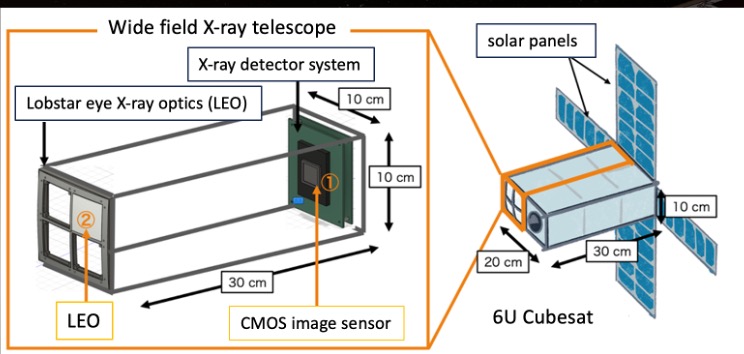
重力波源の電磁波対応天体の探査のための宇宙広視野X線モニターの開発 III(2024-2026年度)(代表:坂本 貴紀 物理科学科 教授 分担者:芹野 素子 物理科学科 助教)
2017年8月17日、中性子星同士の合体に伴った重力波からの電磁波対応天体が発見され、いよいよ重力波天文学の幕開けとなった。この電磁波対応天体からは、キロノバ放射と呼ばれる、重元素合成のプロセスとして不可欠な速い中性子捕獲反応から生成される不安定原子核からの放射や重力波源に付随していたと考えられるガンマ線バーストが観測された。我々は、今後、地上重力波検出器、LIGO, Virgo そして KAGRAが最高感度で天体からの重力波を検出する時代を迎えるにあたり、その電磁波対応天体を探査できる、日本独自の飛翔体観測機器を用いた広視野軟X線モニターの検討、および開発を進める。重力波検出器で決定される重力波の到来方向の精度は数10-100平方度であり、一度に大きな空の領域を高い感度で観測できる観測装置が必須である。また、X線という波長は、可視光などに比べて天体が込み入っていないため、未同定天体の探査が容易であるとメリットがある。我々は、この目的を達成するために、「ロブスターアイ」という光学系とX線撮像素子を用いた高感度広視野X線望遠鏡の6Uキューブサットでの実現を目指す。

実用高温超伝導材料機能開拓プロジェクト(2024-2026年度)(代表:下山 淳一 物理科学科 教授 分担者:元木 貴則 物理科学科 助教)
高温超伝導材料は、送電ケーブル、電磁石、バルク磁石、SQUID素子など様々な用途に実用されているが、その普及は十分でなく、その原因は材料が高価、材料特性が“使えるレベル”に達しただけで、さらに超伝導接合技術など周辺技術が未熟であることなどである。そこで本プロジェクトでは既に実用されているまたは実用が近い材料特性の高機能化に集中した研究を進めている。これは材料の実質的な低価格化、応用領域の拡大だけでなく、材料の均質性や超伝導体表面状態の改善を伴うため接合の形成による永久電流回路の開発まで見通したものである。
本プロジェクトでは具体的には、銅酸化物高温超伝導線材(Y系)の高機能化(青学大-住友電工)、MgB2超伝導体の高機能化(青学大-東ソー)、Y系高温超伝導線材間の高汎用性超伝導接合開発:(青学大-TEP[JSTみらいプロジェクト])などの研究を企業との共同研究の形で実施しているほか、NEDOプロジェクトではY系バルク材料の開発研究、また新規構造のBi系線材の設計開発も進めている。
トポロジカル材料系における特異な電磁場応答の研究(2024-2026年度)(代表者:古川 信夫 物理・数理学科 教授 分担者:廣澤 智紀 物理科学科 助教)
電磁波には電場成分と磁場成分があり、通常はそれぞれ固体の電気分極(正負の電荷分布)と磁気分極(N極S極の分布)と相互作用を行う。しかし、一部の材料系に置いては、電場(磁場)成分と相互作用する磁気(電極)分極が存在し、交差相関効果や電気磁気効果と呼ばれる。これらは、エレクトロマグノンによるTHz帯での強い電波吸収や、非相反効果によるマイクロ波ダイオードなどの新規エレクトロニクス素子への応用が期待される。磁性体において電気磁気効果を発現させるには特定の低い対称性をもつ格子または磁気構造が要求されるため、通常の磁性体材料とは異なるアプローチの研究開発が必要である。
本研究においては、トポロジカル磁性体における特異な磁気構造としてスカーミオン格子系やトロイダルモーメント系などをとりあげ、これらの磁気構造が電気磁気効果を示すこと、静的外場による磁気構造の変化によって電磁波応答が変化すること、特にトポロジー数(整数)によって制御された磁気構造の電磁波応答が量子化(デジタル化)されることなどを示し、デバイスへの応用に資する様々な知見を得ることを目的とする。

冷却 Rb Rydberg 原子が自発的に形成する分子状態の検出及び分子生成のためのマイクロアトムトラップの導入(2024-2026年度)(代表者:前田 はるか 物理・数理学科 教授 分担者:北野 健太 物理科学科 助教)
本プロジェクト研究では、低温かつ高密度に冷却された原子ガスをRydberg状態に励起した、冷却Rydberg原子ガス系を対象に、そこに現れる量子多体効果の一例である、自発生成分子・クラスター構造に着目し、具体的には分子・クラスター構造を実験的に検出し、ひいては自発生成のメカニズムを理解することを目指して行われる。同時に、一つ一つの冷却 Rydberg 原子を超高真空中に配列させ、それにより分子生成条件を精密制御するための装置、いわゆるマイクロアトムトラップの作成を計画する。更には、高密度の原子・分子ガスに自発的に発現する量子多体効果の典型例の一つである超蛍光(超放射)現象について、2D MOT(画像参照。中央に細長くトラップされた冷却Rb原子からの発光が確認できる)にペンシル型の高密度冷却原子サンプルを準備し、分子状態が関与する非線形量子光学過程の解明を目指す。

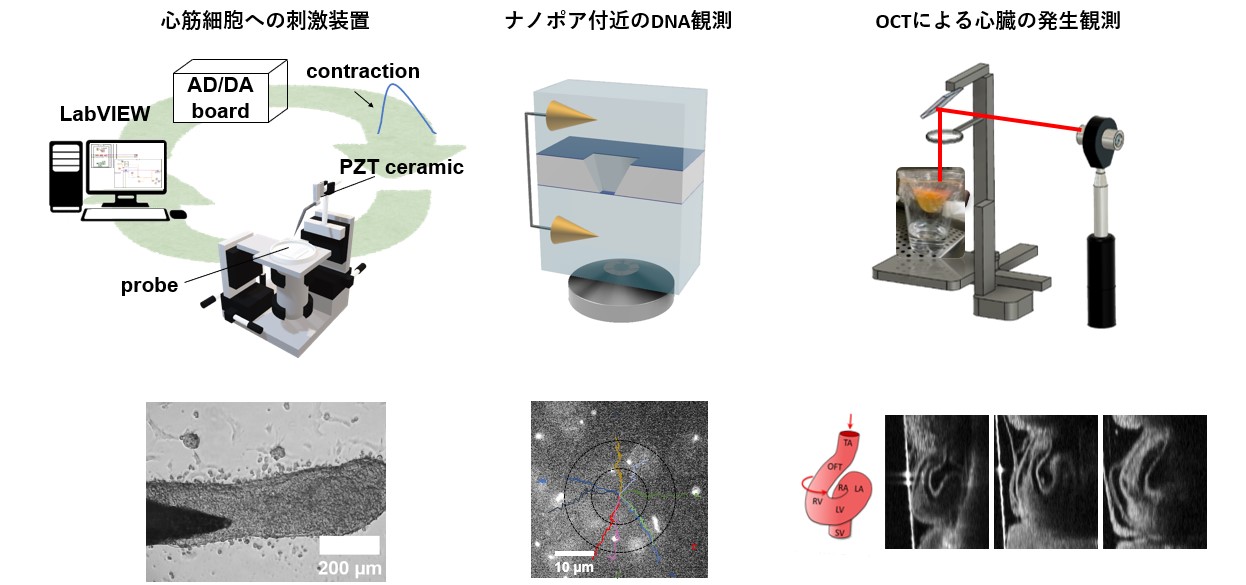
ナノポアやナノスリットと高分子の相互作用と心筋細胞のダイナミクス(2024-2026年度)(代表者:三井 敏之 物理科学科 教授 分担者:守山 裕大 物理科学科 助教)
半導体ベースのナノポアによるDNAの一分子検出は、シークエンス技術としては課題があるが、ウイルス検出やDNAとタンパク質の相互作用を観察するセンサーとして有望である。しかし、DNAと半導体材料表面の相互作用やイオン溶液の種類によるDNAの動態には未解明な点が存在する。そこで、我々は特徴的なナノポアを作製し、蛍光プローブで可視化したDNAの動きを追跡し、ポア周辺の物理的流れや電場の強度を評価する。また、有限要素法を用いた数値シミュレーションと実験結果から、表面電荷などの物理量を推定する。さらに、鶏やゼブラフィッシュの胚や細胞を用いて、心筋細胞の拍動に対するメカニカル刺激の応答や、化学薬品が与える影響、生体内環境に近いPDMSやゲルなどのソフトマテリアル上での細胞ダイナミクスも研究している。この研究は、基礎的な発生メカニズムから心臓疾患の理解まで、幅広い貢献を目指している。

環境基盤技術としての機能性無機薄膜の創成(2024-2026年度)(代表者:重里 有三 化学・生命科学科 教授 分担者:金 旼奭 化学・生命科学科 助教)
酸化物、窒化物、水素化物、炭化物、合金等の無機薄膜の中には、ユニークで高度な物性を発現するものが多くあり、環境技術や情報技術の根幹を支える機能性材料として更なる研究・開発の展開が期待されている。これらの高機能性薄膜材料は先端産業の幅広い分野において使用され、現代社会を支える重要な基盤技術となっている。本研究プロジェクトでは、次世代の環境技術、情報技術を構築するために必要不可欠である機能性無機薄膜材料に関して、多岐にわたる高レベルの物性を発現するための高次微細構造制御、並びに実用化に耐えうる超高速度成膜を確立することを目的としている。産業技術総合研究所との連携大学院、ドイツのダルムシュタット工科大学、フラウンホーファ研究所(FEP)、そして千葉大学先進科学センターとの共同研究、あいちシンクロトロン光センターとの連携等を行っている。
動物の高次生体機能の解析(2024-2026年度)(代表者:平田 普三 化学・生命科学科 教授 分担者:和田 清二 化学・生命科学科 助教)
生物は知覚、記憶、学習、情動、判断といった高次機能をもちあわせています。これを可能にするのは神経系です。では、神経系はどのように形成され、これらの機能を発揮するのでしょうか。私たちはゼブラフィッシュという熱帯魚をモデルとして、神経系による高次機能の解明を進めています。ゼブラフィッシュを用いた行動実験から、たった1つの化学反応がシナプス(神経細胞間の接続部分)におけるタンパク質動態を変化させて、動物の行動変化を引き起こし、これが環境適応を可能にすることを明らかにしました。私たちは現在、光の色や、音、温度などの行動変化のきっかけとなる環境要因と神経系の高次機能すなわち脳活動の関係について、さまざまな視点から明らかにしようと新たな研究をスタートしています。また、ゲノム編集技術CRISPR/Cas9を用いて、さまざまな高次機能障害の魚を作り、病態発症のメカニズムを解明してきました。脳が過剰興奮することでてんかん発作を発症する魚を作製し、その症状を軽減する化合物のスクリーニングから、てんかんを改善する薬の創造も行っています。これらの脳科学研究を通して、ヒトが健康で豊かな生活を送れるよう貢献してまいります。
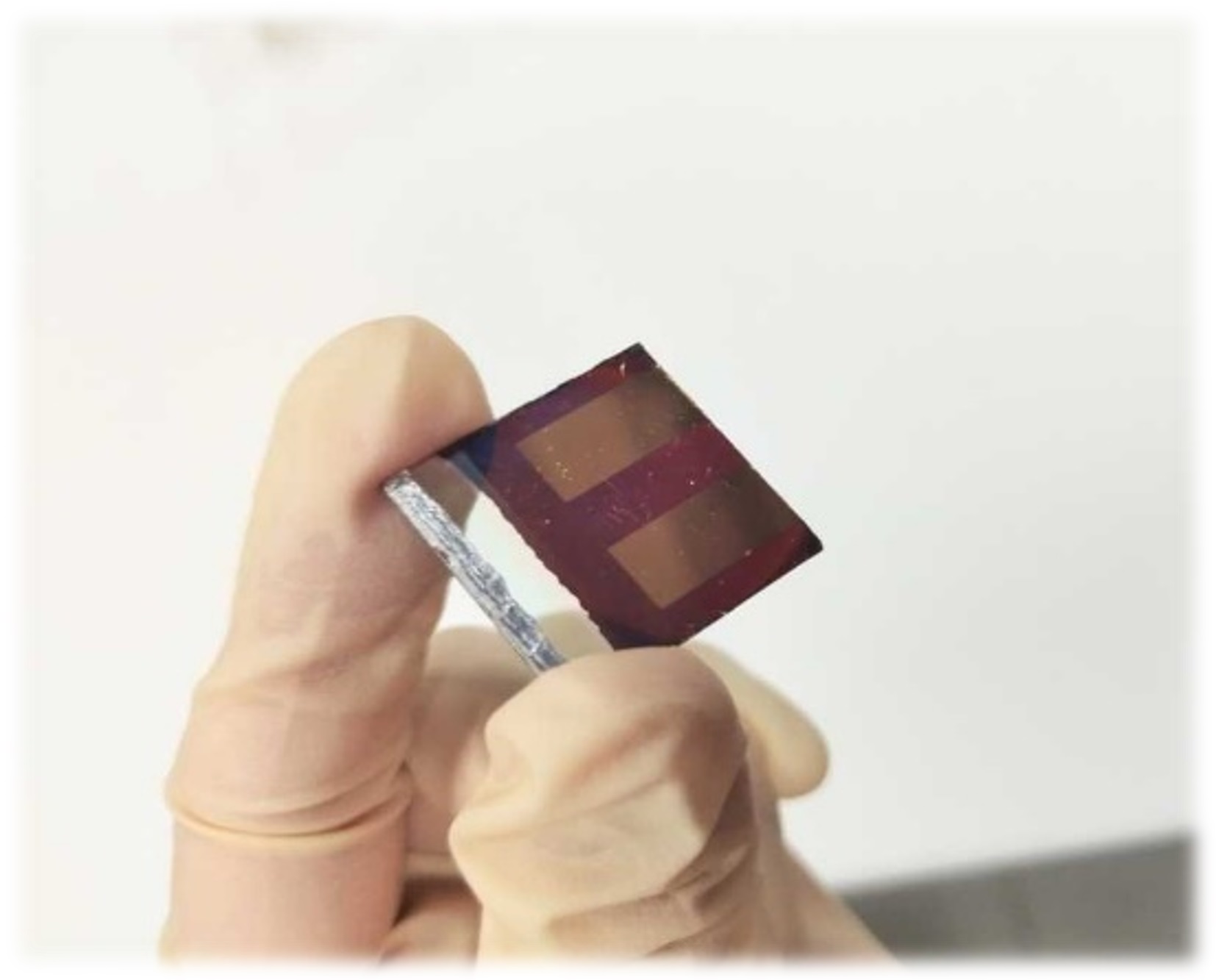
屋内環境用高効率ペロブスカイト太陽電池の開発(2024-2026年度)(代表者:石河 泰明 電気電子工学科 教授 分担者:來福 至 電気電子工学科 助教)
様々なモノの状態をセンシングしインターネットなどのネットワークに繋げるIoTセンサーが注目されているが、IoTセンサーへの電力供給は電池などのバッテリーが依然として主であり、軽量化やメンテナンスフリー化に向けて、設置された環境にあるエネルギーを利用する環境発電が重要な役割を担うと考えられている。本研究では、屋内環境に設置されるIoTセンサーへの電力供給を目指し、屋内光を高効率に電気に変換するペロブスカイト太陽電池を開発する。ペロブスカイト太陽電池は、発電層となるペロブスカイト層の組成を変えることで屋内光を効果的に吸収する材料に調整可能である。太陽光照度に比べ屋内光照度は1/200~1/1000程度しかなく、このような低照度環境下でもペロブスカイト太陽電池は30%以上の光電変換効率が期待できる。しかし、屋内環境に合わせたペロブスカイト太陽電池とするにあたり、発電層の電子物性不安定化が課題となっている。本研究は、発電層の電子物性安定化、及び高い変換効率の実現を目指しペロブスカイト層の光物性を探索する。

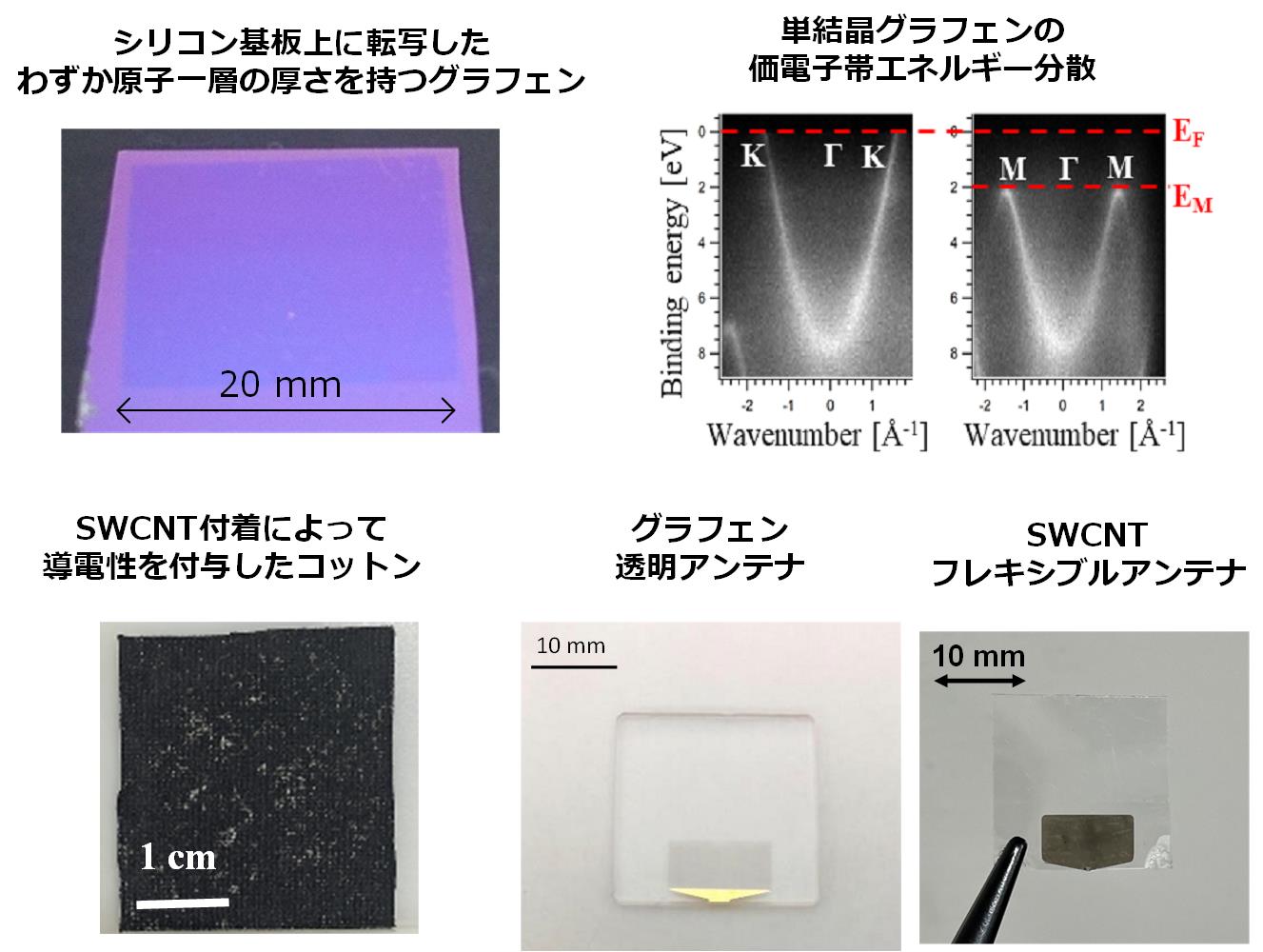
ナノカーボン材料を用いた新規デバイスの開発(2024-2026年度)(代表者:黄 晋二 電気電子工学科 教授 分担者:渡辺 剛志 電気電子工学科 助教)
グラフェンやカーボンナノチューブ(CNT)などのナノカーボン材料は、優れた電気伝導性、光学的透明性、優れた機械的性質、高い熱伝導率、高い生体親和性などの特異な物性を持つことから大きな注目を浴び、そのデバイス応用について精力的に研究が進められています。本研究では、これらの性質を活用するデバイスに関する研究に取り組んでいます。デバイス応用において優れた物性を最大限に引き出すためには、基盤技術である材料の結晶成長、及び合成技術が重要だと考えています。ナノカーボン材料では、原子層数を精密に制御した一様なシート状のグラフェン膜やグラフェンフレーク・CNTを溶媒中に分散させたインクなど様々な形態の材料を作製することが可能です。本研究では、各デバイス応用に最適な形態・物性を持つ材料を作製し、デバイスの高性能化を達成しようと取り組んでいます。具体的には、グラフェン透明導電膜、グラフェン電気化学電極、CNTを付着させた導電布などに関する基礎研究とデバイス応用を進めています。

マルチフェーズワイヤレス送電システムの改良研究(2024-2026年度)(代表者:松本 洋和 電気電子工学科 教授 分担者:佐藤 佑樹 電気電子工学科 助教)
ワイヤレス送電技術はケーブルを接続することなく、電子機器を充電することができる技術である。充電が簡便に行えるため、携帯電話の充電器として普及が進んでいる。その大きな特長は移動体への送電が可能な点である。現在の電気自動車では航続距離が短い上、充電時間が長く更には高価で重量が大きい積載バッテリーが普及の障害となっている。ワイヤレス送電技術はこれらを解決するための一つの手段であると考えられている。
私達が提案している三相ワイヤレス送電システムはそれぞれ異なる電流が流れる3つの相コイルをワンセットとして構成され、三相インバータにより電力が供給される。このシステムでは隣り合うコイルが互いの磁界を強めあうため密着してコイルを設置でき、電力をシームレスで送れることから、移動体への送電に適している。本研究プロジェクトでは、このシステムについて、効率の向上や漏れ磁束の低減など、各種特性を改善するため、コイルや回路、そして制御系の改良を行う予定である。
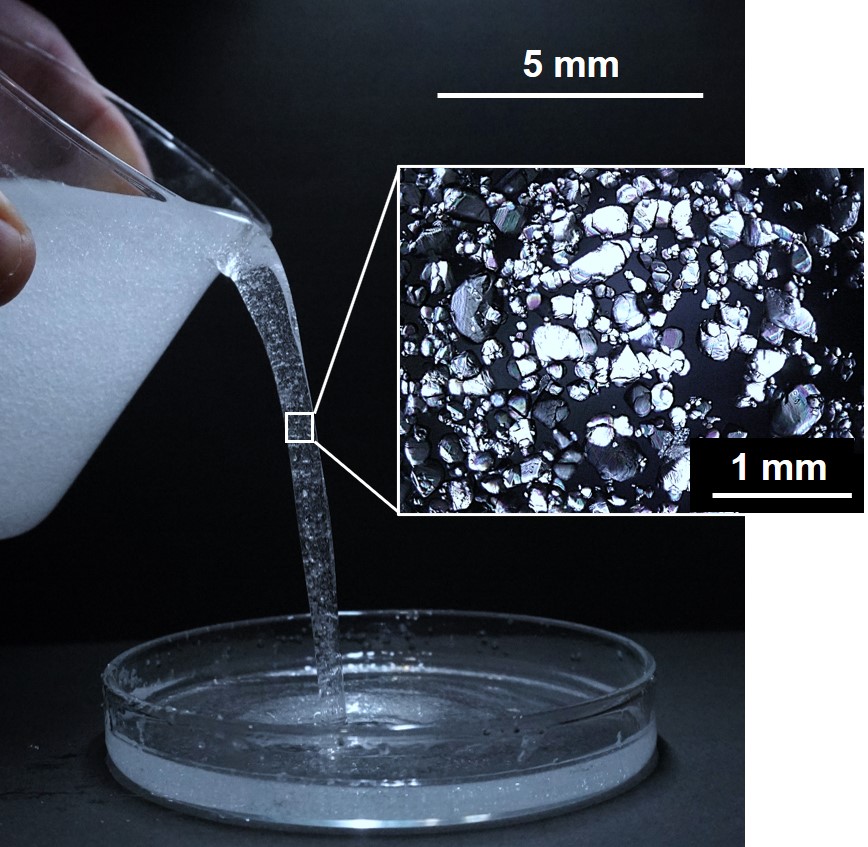
糖アルコールスラリーの伝熱特性および結晶成長速度の評価(2024-2026年度)(代表者:熊野 寛之 機械創造工学科 教授 分担者:森本 崇志 機械創造工学科 助教)
潜熱蓄熱材として利用されている糖アルコールを液中に分散させた糖アルコールスラリーは、糖アルコールの固液相変化潜熱による高い蓄熱密度に加えて、流動性を有する蓄熱材として注目されており、太陽光の集熱システム等における、蓄熱・熱輸送媒体としての利用が期待されている。しかしながら、糖アルコールの場合、水溶液からの結晶の生成が極めて遅く、一定時間に予期していた量の結晶を得られないことが示唆されている。糖アルコールの結晶量はシステムの蓄熱可能量に相当するため、結晶析出量の予測が必要不可欠である。また、蓄熱放熱運転時には、熱移動速度が重要となるため、糖アルコールスラリーの伝熱特性を明らかにする必要もある。そこで、本研究では、糖アルコール水溶液からの糖アルコール結晶の析出速度を予測できるようなモデルを提案するとともに、配管に糖アルコールスラリーを流動させた時の伝熱特性を調べることで、糖アルコールスラリーを利用した潜熱蓄熱システム構築のための基礎的な知見を得ることを目的としている。

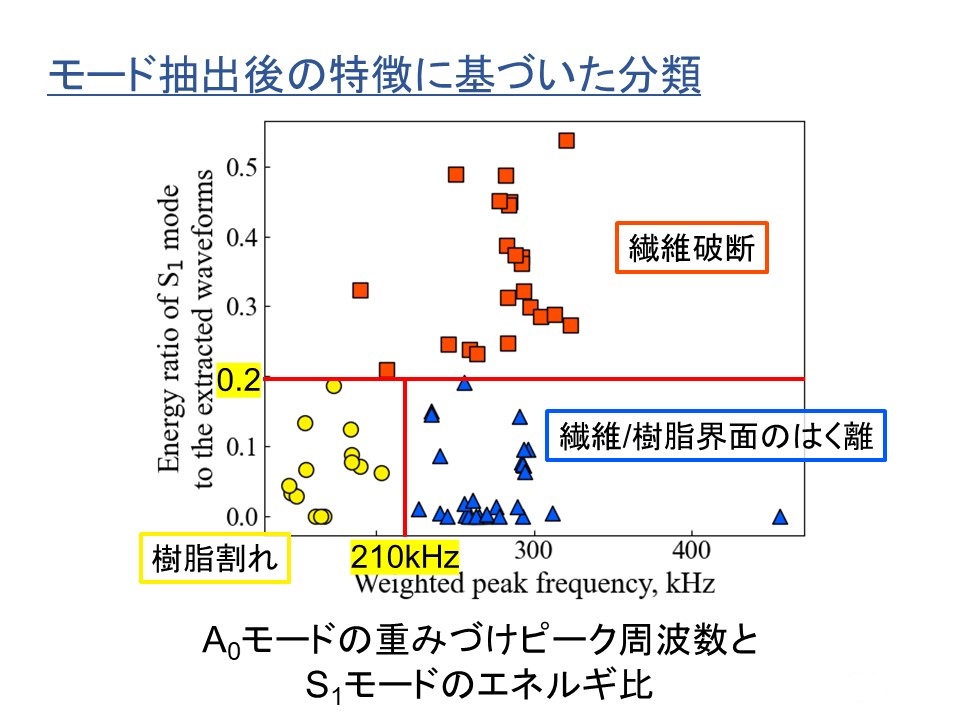
機械学習を用いたAE波形分類と損傷挙動の推定(2024-2026年度)(代表者:長 秀雄 機械創造工学科 教授 分担者:西宮 康治朗 機械創造工学科 助教)
炭素繊維強化複合材料(CFRP)は、比強度・比剛性に優れた材料であり、今後は様々な場面での使用が期待される。一方で、CFRPは炭素繊維とマトリックス樹脂で構成されているため、その損傷には樹脂割れ、繊維/樹脂界面破壊、層間はくり、繊維破断など多くの損傷形態が存在する。その中でも繊維破断はCFRPの健全性を著しく損なうため、繊維破断の前の損傷形態を評価し、繊維破断の兆候をつかむことが重要となる。本プロジェクトで利用するアコーステック・エミッション(Acoustic Emission: AE)は、損傷に伴って発生する弾性波(超音波)であり、破壊に関する様々な情報を含んでいる。そのためAE波形の特徴と各種損傷を対応づけることができれば、CFRPの損傷過程を評価できる。そこで本プロジェクトではAE波形の特徴を機械学習によって分類し、各種損傷を対応づけることを行う。その際、AE波形が伝搬に伴って歪む現象を定量化し、補正することで確度の高い分類手法の構築を目指す。
※写真:CFRPの損傷によって放出されたAE波の特徴を分類した結果

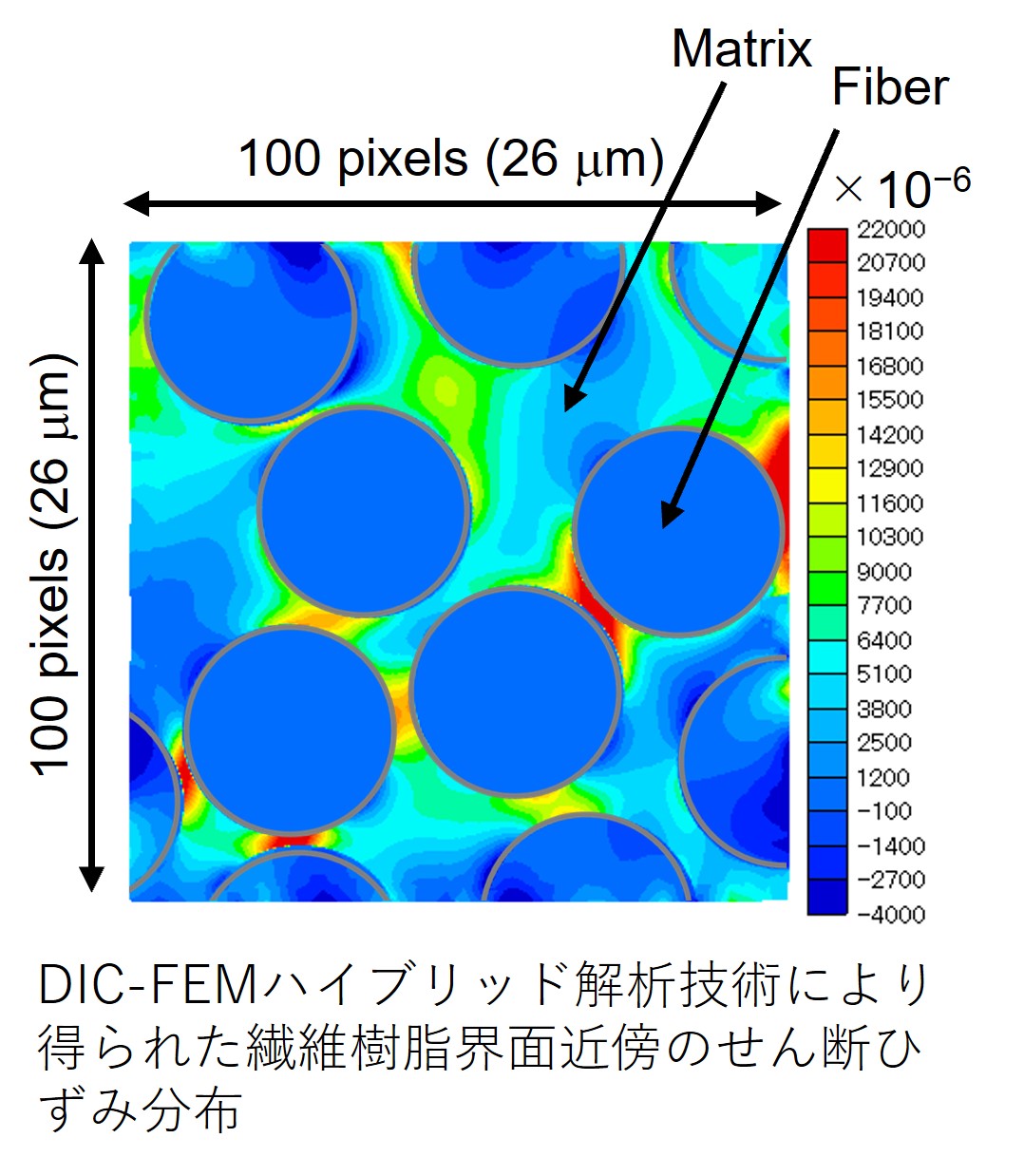
画像計測と数値解析のハイブリッド技術を用いた先進材料のマルチスケール応力・ひずみ解析技術の開発(2024-2026年度)(代表者:米山 聡 機械創造工学科 教授 分担者:飯塚 啓輔 機械創造工学科 助教)
自動車や航空機など各種機械・構造物の軽量化のため、マルチマテリアル化が進み、炭素繊維強化樹脂(CFRP)や高張力鋼の利用が増加している。これらのさらなる軽量化のためには、これら材料の変形および破壊のメカニズムを明らかにするとともに、高精度な破断予測を可能とする必要がある。そこで本プロジェクトでは、DICおよびDVCなどの画像測定技術と、FEMなどの数値解析技術のハイブリッド技術を確立し、高張力鋼やCFRPのひずみを様々なスケールで測定する技術を開発するとともに、その測定結果を利用して材料特性や応力分布を評価する技術を開発する。具体的には、(1) DIC-FEMハイブリッド応力解析技術の確立とその弾塑性および粘弾性材料への拡張、(2) 高張力鋼のくびれ後の応力ひずみ関係の同定と応力分布評価、(3) 3Dプリントエネルギー吸収構造体の変形および破壊挙動の評価、(4)グローバルDVC/FEグローバルDVCを用いたCFRP内部のひずみ測定技術の開発、などの研究を行う。

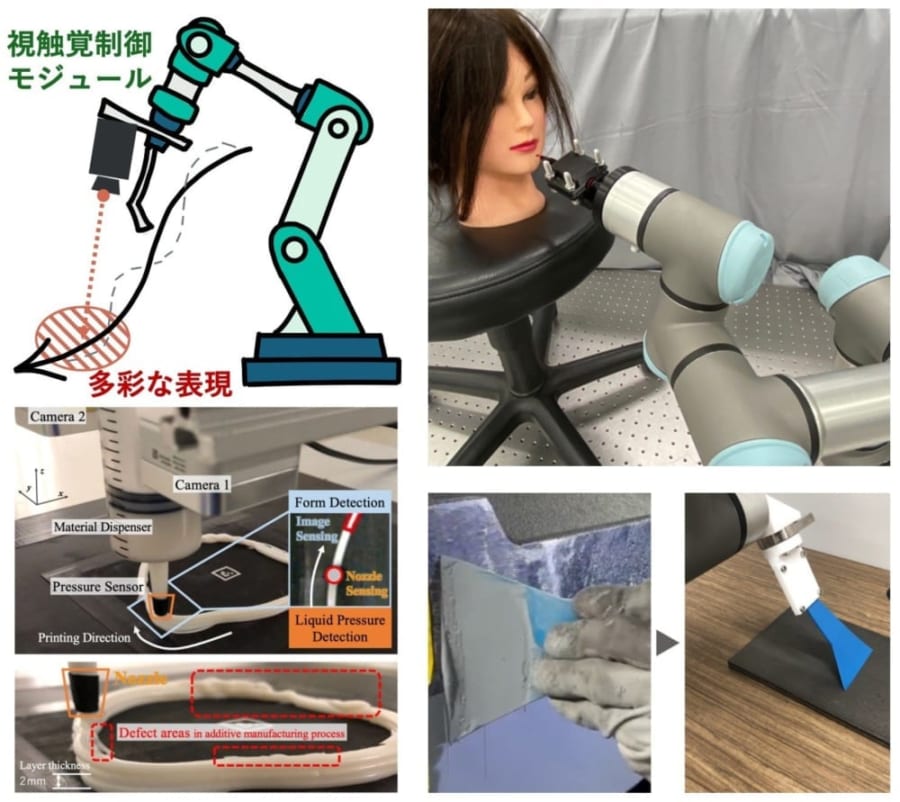
高速3D造形のマルチモーダルセンシングとロボットモーションコントロール(2024-2026年度)(代表者:田崎 良佑 機械創造工学科 准教授)
本プロジェクトは、製造現場において環境・材料・道具の変化に柔軟かつ迅速に適応し、持続的に作業を遂行できる自動化・ロボット化の実現を目指している。そのため、人間の高度な適応能力に近い技能をロボットシステムで具現化することを大きな目標としている。具体的には、「液吐出式3Dプリンタの高速造形」と「工業製品等のメイクアップ仕上げ」の工程において、液体を取り扱う高度な生産技術を確立することに取り組んでいる。本研究では、数値流体力学のモデル予測機能・高速な視覚計測機能・精密な力覚制御機能に基づくロボットマニピュレーション技術の構築に注力している。高速カメラによるリアルタイム画像解析を駆使し、状態推定および動作計画を数ミリ秒単位で実行するための手法を構築し、またそれを具現化するための高速駆動モジュールを開発している。これにより、人間の即興的対応に近い適応能力をもつロボットシステム設計を通じ、多様かつ複雑な液体操作タスクの実現可能性を追求・実証している。

立体選択的合成反応の開発(2024-2025年度)(代表者:武内 亮 化学・生命科学科 教授)
有機分子は三次元の形を持っている。このことから、炭素原子に結合している4つの結合がすべて異なる場合、その分子と鏡に映ったその分子は重ね合わすことができない。実像と鏡像が重ね合わすことができない右手と左手の関係になる。実像と重ね合わすことのできない鏡像を鏡像異性体という。鏡像異性体が存在する分子を光学活性分子という。鏡像異性体の片方だけを高度の選択性を持って合成することは難しく、有機合成において最もチャレンジングな領域である。
複素環化合物は医薬品の基本構造として極めて重要である。それらの中でも、光学活性芳香族複素環化合物の需要は高く、効率的供給法が求められている。本研究では、イリジウム触媒とルイス酸またはブレンステッド酸との協働作用を用いて光学活性芳香族複素環化合物の効率的合成法の確立を行う。また、これらの研究と並行して、有用なビルディングブロックとなるような光学活性多官能性化合物の合成も行う。
高周波ノイズの低減に関する研究開発(2023~2025年度)(代表者:須賀 良介 電気電子工学科 准教授)
無線電力伝送や電気自動車および自動車レーダなど比較的大きな高周波電力を扱うデバイスが増加しています。これらは私達の生活を豊かにする一方で、これらの機器は他の電子機器の誤作動の一因となる不要な電波を放射しています。このような電波環境の悪化を抑えるために、電波吸収体やシールド材が求められており、近年では誘電体基板の表面に波長程度の金属エレメントを周期配列した極めて薄型軽量な電波吸収体が提案されています。この電波吸収体の設計には従来から多大な時間やコストが必要となる電磁界シミュレーションが使われてきました。本研究では、この電波吸収体の所望の吸収特性を実現可能な構造を簡易な計算のみで設計することを目的とし、研究開発を進めています。
環境変動にロバストな定量光位相イメージング技術の開発(2023~2025年度)(代表者:前田 智弘 電気電子工学科 助教 分担者:外林 秀之 電気電子工学科 教授)
光波の位相には光波がこれまで辿ってきた経路の情報が含まれることから、光位相分布には、物体の微妙な凹凸や生体組織の僅かな組成の違いが現れます。光波の干渉を利用した光位相計測技術である位相シフトディジタルホログラフィ(PSDH)は、光位相分布を高精度かつ定量的に算出することが可能なため、工業製品の検査や生体組織の計測などの領域で近年注目を集めています。PSDHの計算には干渉させる2光波間に位相シフトを与えて取得した複数の干渉縞が必要となり、これまでに様々な位相シフト法が検討されています。
私たちは、『市松模様状の回折格子が光波を複製する』という興味深い現象を利用した全く新しい位相シフト法を提案しています。提案技術では、回折によって生じた物体光の複製に参照光を一様照射することで、PSDHの計算に必要となる複数の干渉縞画像を一括で取得することができます。さらに、複製の効果は回折格子の位置に依存しないことから、光学素子の位置関係の変動に対するロバスト性にも優れています。本研究プロジェクトでは、回折格子の試作や位相計測精度の評価などを通じて、時間的・空間的な変動に対してロバストな光位相計測技術の確立を目指しています。